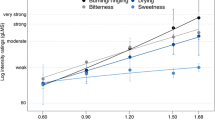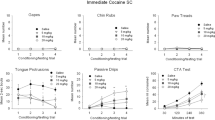Abstract
A taste-aversion paradigm was used to demonstrate that aversive consequences accompany the rapid oral ingestion of 5% (v/v) ethanol solutions. The learned taste aversion resulted from five 10-min self-administrations of alcohol mixed with an originally preferred flavor at a dosage of 1.69 g alcohol/kg body weight/day. In contrast, when the consumption of the alcohol solution was distributed throughout the day, a conditioned aversion was not obtained. This outcome was observed even though the distributed drinking animals were exposed to more orosensory stimuli and ingested more g/kg than the 10-min animals. The observation that those animals that drank their daily fluid in 10 min demonstrated higher peak blood-alcohol levels than the distributed animals supports the conclusion that a centrally mediated aversive state of inebriation must be present to produce a conditioned aversion.
Similar content being viewed by others
References
Amit, Z., Ziskind, D., Baum, M.: Drug effects and avoidance-extinction in rats: A test of the drug novelty hypothesis using ethanol. Anim. Learn. Behav. 1, 41–43 (1973)
Berman, R., Cannon, D.: The effect of prior ethanol experience on ethanol-induced saccharin aversions. Physiol. Behav. 12, 1041–1044 (1974)
Carey, R.: A decrease in ethanol preference in rats resulting from forced ethanol drinking under fluid deprivation. Physiol. Behav. 8, 373–375 (1972)
Eckardt, M.: Conditioned taste aversion produced by the oral ingestion of ethanol in the rat. Physiol. Psychol. (in press, 1975)
Gillespie, R., Lucas, C.: An unsuspected factor which influences consumption of alcohol by rats. Nature (Lond.) 180, 1292–1293 (1957)
Goldberg, L., Rydberg, U.: In: Automation in analytical chemistry, L. Sheggs, ed., pp. 595–600. New York: Mediad 1965
Kalant, H.: Absorption, diffusion, distribution, and elimination of ethanol: Effects on biological membranes. In: The biology of alcoholism, B. Kissin and H. Begleiter, eds., vol. 1, pp. 1–62. New York: Plenum 1971
Lester, D.: Self-selection of alcohol by animals, human variation, and the etiology of alcoholism: A critical review. Quart. J. Stud. Alcohol 27, 395–438 (1966)
Lester, D., Nachman, M., Le Magnen, J.: Aversive conditioning by ethanol in the rat. Quart. J. Stud. Alcohol 31, 578–586 (1970)
Marfaing-Jallat, P., Pruvost, M., Le Magnen, J.: La consommation d'éthanol par auto-administration intragastrique chez le rat. J. Physiol. (Paris) 68, 81–95 (1974)
Myers, R., Veale, W.: The determinants of alcohol preference in animals. In: The biology of alcoholism, B. Kissin and H. Begleiter, eds., vol. 2, pp. 131–168. New York: Plenum 1972
Richter, C. P.: A study of the effect of moderate doses of alcohol on the growth and behavior of the rat. J. exp. Zool. 44, 397–418 (1926)
Author information
Authors and Affiliations
Rights and permissions
About this article
Cite this article
Eckardt, M.J. The role of orosensory stimuli from ethanol and blood-alcohol levels in producing conditioned taste aversion in the rat. Psychopharmacologia 44, 267–271 (1975). https://doi.org/10.1007/BF00428905
Received:
Revised:
Issue Date:
DOI: https://doi.org/10.1007/BF00428905




